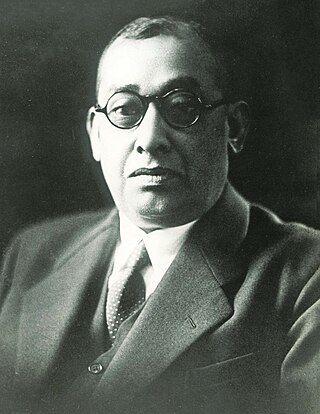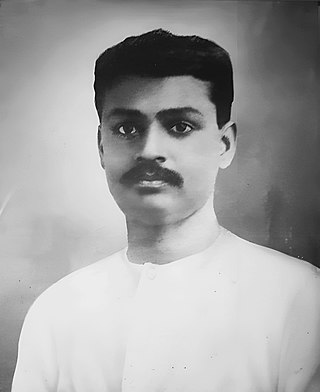
The Indian independence movement was a series of historic events with the ultimate aim of ending British rule in India also known as British Raj. It lasted until 1947.

Rash Behari Bose was an Indian revolutionary leader who fought against the British Empire. He was one of the key organisers of the Ghadar Mutiny and founded the Indian Independence League. Bose also led the Indian National Army (INA) which was formed in 1942 under Mohan Singh.

Bagha Jatin or Baghajatin, born Jatindranath Mukherjee ; 7 December 1879 – 10 September 1915) was an Indian independence activist.

Basanta Kumar Biswas was an Indian pro-independence activist involved in the Jugantar group who, in December 1912, played a role in the bombing of the Viceroy's parade in what came to be known as the Delhi-Lahore Conspiracy.

Anushilan Samiti was an Indian fitness club, which was actually used as an underground society for anti-British revolutionaries. In the first quarter of the 20th century it supported revolutionary violence as the means for ending British rule in India. The organisation arose from a conglomeration of local youth groups and gyms (akhara) in Bengal in 1902. It had two prominent, somewhat independent, arms in East and West Bengal, Dhaka Anushilan Samiti, and the Jugantar group.
The Revolutionary movement for Indian Independence was part of the Indian independence movement comprising the actions of violent underground revolutionary factions. Groups believing in armed revolution against the ruling British fall into this category, as opposed to the generally peaceful civil disobedience movement spearheaded by Mahatma Gandhi.
Jugantar or Yugantar was one of the two main secret revolutionary trends operating in Bengal for Indian independence. This association, like Anushilan Samiti, started in the guise of suburban fitness club. Several Jugantar members were arrested, hanged, or deported for life to the Cellular Jail in Andaman and many of them joined the Communist Consolidation in the Cellular Jail.
Kunwar Pratap Singh Barhath, also known as ‘Kunwar Ji’, was an Indian anti-British activist known for his role in the revolutionary plot to assassinate the Viceroy of India, Charles Hardinge, in 1912. He was a prominent member of the Revolutionary Party led by Rash Behari Bose.

The Kakori Train robbery was a train robbery that took place at Kakori, a village near Lucknow, on 9 August 1925, during the Indian independence movement against the British rule in India. It was organized by the Indian revolutionaries of Hindustan Republican Association (HRA).
The Indian Independence League was a political organisation operated from the 1920s to the 1940s to organise those living outside British India into seeking the removal of British colonial rule over the region. Founded by Indian nationalists, its activities were conducted in various parts of Southeast Asia. It included Indian expatriates, and later, Indian nationalists in-exile under Japanese occupation following Japan's successful Malayan Campaign during the first part of the Second World War. During the Japanese Occupation of Malaya, the Japanese encouraged Indians in Malaya to join the League.
The Hindu–German Conspiracy(Note on the name) was a series of attempts between 1914 and 1917 by Indian nationalist groups to create a Pan-Indian rebellion against the British Empire during World War I. This rebellion was formulated between the Indian revolutionary underground and exiled or self-exiled nationalists in the United States. It also involved the Ghadar Party, and in Germany the Indian independence committee in the decade preceding the Great War. The conspiracy began at the start of the war, with extensive support from the German Foreign Office, the German consulate in San Francisco, and some support from Ottoman Turkey and the Irish republican movement. The most prominent plan attempted to foment unrest and trigger a Pan-Indian mutiny in the British Indian Army from Punjab to Singapore. It was to be executed in February 1915, and overthrow British rule in the Indian subcontinent. The February mutiny was ultimately thwarted when British intelligence infiltrated the Ghadarite movement and arrested key figures. Mutinies in smaller units and garrisons within India were also crushed.

Sachindra Nath Sanyal was an Indian revolutionary and co-founder of the Hindustan Republican Association that was created to carry out armed resistance against the British Empire in India. He was a mentor for revolutionaries like Chandra Shekhar Azad, Jatindra Nath Das, and Bhagat Singh.
The Ghadar Mutiny, also known as the Ghadar Conspiracy, was a plan to initiate a pan-India mutiny in the British Indian Army in February 1915 to end the British Raj in India. The plot originated at the onset of World War I, between the Ghadar Party in the United States, the Berlin Committee in Germany, the Indian revolutionary underground in British India and the German Foreign Office through the consulate in San Francisco. The incident derives its name from the North American Ghadar Party, whose members of the Punjabi community in Canada and the United States were among the most prominent participants in the plan. It was the most prominent amongst a number of plans of the much larger Hindu–German Mutiny, formulated between 1914 and 1917 to initiate a Pan-Indian rebellion against the British Raj during World War I. The mutiny was planned to start in the key state of Punjab, followed by mutinies in Bengal and rest of India. Indian units as far as Singapore were planned to participate in the rebellion. The plans were thwarted through a coordinated intelligence and police response. British intelligence infiltrated the Ghadarite movement in Canada and in India, and last-minute intelligence from a spy helped crush the planned uprising in Punjab before it started. Key figures were arrested, and mutinies in smaller units and garrisons within India were also crushed.

Vishnu Ganesh Pingle was an Indian revolutionary and a member of the Ghadar Party who was one of those executed in 1915 following the Lahore conspiracy trial for his role in the Ghadar conspiracy.
The first Christmas Day plot was a conspiracy made by the Indian revolutionary movement in 1909: during the year-ending holidays, the Governor of Bengal organised at his residence a ball in the presence of the Viceroy, the Commander-in-Chief and all the high-ranking officers and officials of the Capital (Calcutta). The 10th Jat Regiment was in charge of the security. Indoctrinated by Jatindranath Mukherjee, its soldiers decided to blow up the ballroom and take advantage of destroying the colonial Government. In keeping with his predecessor Otto von Klemm, a friend of Lokmanya Tilak, on 6 February 1910, M. Arsenyev, the Russian Consul-General, wrote to St Petersburg that it had been intended to "arouse in the country a general perturbation of minds and, thereby, afford the revolutionaries an opportunity to take the power in their hands." According to R. C. Majumdar, "The police had suspected nothing and it is hard to say what the outcome would have been had the soldiers not been betrayed by one of their comrades who informed the authorities about the impending coup".
Bhai Balmukund was an Indian revolutionary freedom fighter. He was sentenced to death and hanged by the British Raj for his role in Delhi conspiracy case. He was a cousin of another revolutionary Bhai Parmanand, who was a founder member of Ghadar Party.
The history of the Anushilan Samiti stretches from its beginning in 1902 to 1930. The Samiti began in the first decade of the 20th century in Calcutta as conglomeration of local youth groups and gyms(Akhra). However, its focus was both physical education and proposed moral development of its members. From its inception it sought to promote what it perceived as Indian values and to focus on Indian sports e.g. Lathi and Sword play. It also encouraged its members to study Indian history as well as those of European liberalism including the French Revolution, Russian Nihilism and Italian unification. Soon after its inception it became a radical organisation that sought to end British Raj in India through revolutionary violence. After World War I, it declined steadily as its members identified closely with leftist ideologies and with the Indian National Congress. It briefly rose to prominence in the late second and third decade, being involved in some notable incidents in Calcutta, Chittagong and in the United Provinces. The samiti dissolved into the Revolutionary Socialist Party in 1930.
The Rodda company arms heist took place on 26 August 1914 in Calcutta, British India. Members of the Jugantar faction of the Bengali revolutionary organisation Anushilan Samiti intercepted a shipment of Mauser Pistols and ammunition belonging to Messrs Rodda & co., a Calcutta gun dealer, while these were en route from the Customs house to the company's godown, and were able to make away with a portion the arms. The heist was a sensational incident, being described by The Statesman as the "Greatest daylight robbery". In the following years, the pistols and ammunitions were linked to almost all the incidences of nationalist struggles in Bengal. By 1922, the police had recovered most of the stolen arms.
Manindra Nath Nayak was a Bengali revolutionary and Indian independence activist.
Thakur Zorawar Singh Barhath was an Indian revolutionary and independence activist. He is known for the assassination attempt on the Viceroy of India, Lord Hardinge, by throwing a bomb at him during a procession in New Delhi.









